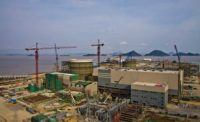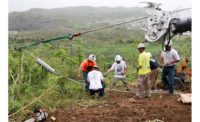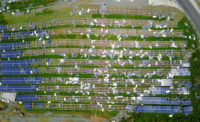As workers struggle to restore power in Puerto Rico and the U.S. Virgin Islands, companies and government agencies are looking for ways to make the islands’ power grids more resilient and better able to withstand future storms. Rather than wait for the government go-ahead, some companies are preparing plans for when they get the green light and reaching out to private industry.
“In our minds, it is an almost perfect setting to demonstrate what the future of power grids could be,” says Tom Lewis, president of Louis Berger U.S. In addition to being the Army Corps of Engineers contractor on the agency’s emergency generator mission, the company is readying itself with a tool box of approaches to help harden the grids in Puerto Rico and U.S. Virgin Islands.
Louis Berger is approaching potential clients, such as pharmaceutical companies and hotels, through insurance companies, offering to build microgrids and provide other solutions that would keep their businesses and surrounding communities operational during a storm.
Likewise, Black & Veatch is preparing to present distributed-generation solutions to the Army Corps of Engineers and other agencies, and Burns & McDonnell soon will meet with the Energy Dept. to discuss program management opportunities for building a more resilient grid.
Lewis and Black & Veatch and Burns & McDonnell executives agree that the ideal configuration for the islands’ power grids would be some combination of a traditional grid interconnected to microgrids for critical infrastructure, businesses and remote areas. The microgrids, powered by renewable power or traditional generators, could disconnect from the grid when a storm approaches and supply a small area with electricity during and following a disaster. On a day-to-day basis, the power supplied by the microgrids could help to lower the cost of electricity and even supply excess power to the overall grid, lowering the overall demand for power from the utility.
Residents of Puerto Rico pay up to three times more for electricity—about 30¢ per kwH—than most other U.S. residents.
Further, the overall grid could be powered by a combination of liquefied natural gas, a much greater portion of wind and solar power, and the island’s existing coal plant, operating since 2002. Puerto Rico Gov. Ricardo Rossello (D) told a congressional committee that, in the short term, he would like to increase the island’s renewable power up to 25% from the current 2%. Other improvements could include selective undergrounding of distribution lines in urban areas and other hardening measures, such as composite poles.
The federal government is looking at hardening and resiliency measures through the Energy Dept.’s Grid Modernization Laboratory Consortium, a collaborative effort of energy labs.
Bruce Walker, assistant secretary for the Energy Dept.’s office of electricity delivery and reliability, told a Senate committee that DOE is considering improving modeling and relays, building microgrids and storm-hardening portions of the grid.
Furthermore, DOE is examining ASCE Standard 24-14 for flood-resistant design and construction and looking at National Oceanic and Atmospheric
Administration studies to determine where mountains would block solar panels and where substations would be less vulnerable to flooding. Eighteen substations on Puerto Rico flooded, Walker notes. By contrast, none of the U.S. Virgin Islands’ substations flooded because they were enclosed in concrete structures, the territory’s governor, Kenneth Mapp (I), told the committee.
Still, there is much work to be done on the U.S. Virgin Islands, Mapp said.
“This is the fifth time the U.S. government is paying to restore our power distribution system,” Mapp told a Senate committee. “We must build it back stronger and better than before.”
Mapp said his territory also wants to invest in more microgrids and a more-resilient transmission and distribution system, with some buried power lines and composite poles.
‘Avant-Garde’ Costs
“I would like this to be an opportunity to leapfrog from 19th-century technology to an avant-garde” system, Rossello said. On Nov. 12, he requested $94 billion from the federal government to repair damages from Hurricane Maria, specifying $17 billion for the power grid.
The White House on Nov. 17 requested an additional $44 billion in disaster funding from Congress for damage from Hurricanes Harvey, Irma and Maria and West Coast wildfires. If Congress approves the request, total funds for disaster relief would reach about $96 billion.
Senate Appropriations Committee Vice Chairman Patrick Leahy (D-Vt.) said in a statement that the White House request doesn’t come close to what is needed for Puerto Rico and other areas. He said he has received requests for more than $180 billion in federal assistance.
Even Rossello’s $17 billion request might not be enough to rebuild the grid to its ideal configuration, says Mike Beehler, a vice president at Burns & McDonnell. Jason Abiecunas, who leads distributed-generation efforts at Black & Veatch, says the ideal layout could cost between $18 billion and $25 billion—and “it could be more when all is said and done.”
The government’s efforts could be supplemented by individual corporations that are building microgrids to serve the island’s businesses and surrounding communities, as Louis Berger is proposing.
Charities are also stepping up to microgrids and vulnerable power infrastructure. For example, Tesla donated batteries and solar panels to power a children’s hospital in Puerto Rico.
Lewis says communities could create cooperatives to build their own microgrids, and private companies could build generation and sell electricity to the Puerto Rico Power Authority (PREPA) under a power purchase agreement—a common practice in the U.S. that is not employed in Puerto Rico because PREPA is a monopoly.
Resiliency and rebuilding efforts have been slowed by wrangling over the chain of command. A federal board overseeing Puerto Rico’s finances pushed to put retired U.S. Air Force Col. Noel Zamot in charge of the rebuild. While Zamot said he has an extensive plan ready, a federal court rejected his appointment. Then, on Nov. 17, Ricardo Ramos, the head of PREPA who signed a controversial rebuild contract with Whitefish Energy, resigned.
For now, DOE is leading the efforts. A spokesman says the national labs are developing short-, medium- and long-term solutions to improve the resiliency of Puerto Rico’s grid.
But Lewis says that all entities are moving in the same direction to rebuild a more-resilient grid—a message that Rossello and DOE have emphasized in recent congressional hearings.
Restoration Continues
For now, the greatest focus is still on restoring power to the citizens of Puerto Rico. On Nov. 21, almost 50% of power had been restored to Puerto Rico and 30% of power had been returned to the U.S. Virgin Islands. Fluor Corp., which has been contracted by the Army Corps of Engineers to help restore power on Puerto Rico, on Nov. 16 said it had completed a high-priority 38kV power line, near San Juan, that will restore power to an area comprising hospitals, homes and schools.
The company says it is working with 50 crews, including several local subcontractors, to restore power in rural and urban areas and clear the way to get to other damaged lines and substations. Matt Hunt, Fluor’s executive program director for the Puerto Rico power restoration, says, “It’s a huge undertaking.”








Post a comment to this article
Report Abusive Comment